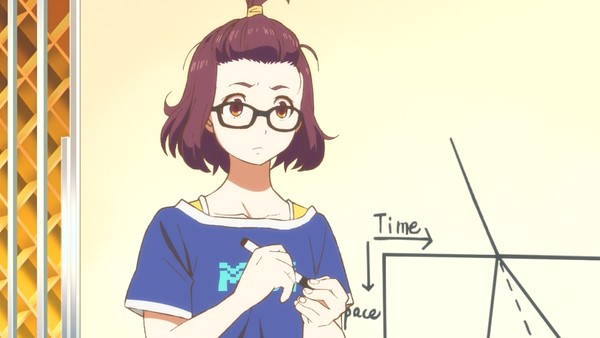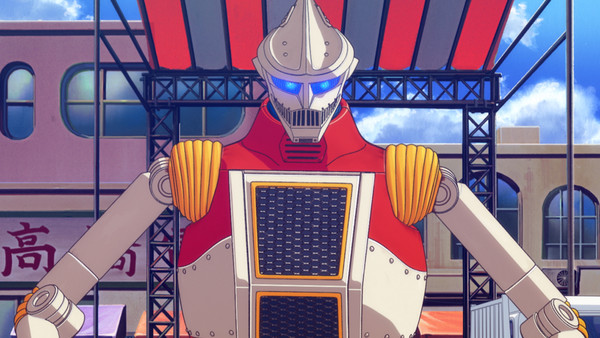The Science of Kaiju with the Director and Writer of Godzilla Singular Point
by Kim Morrissy,Godzilla Singular Point is the newest animated reimagining of the classic kaiju franchise. Atsushi Takahashi directed the anime at Bones, with sci-fi writer and ex-physicist Toh Enjoe writing the script. ANN interviewed these two key figures in anticipation of the anime's global release on Netflix on June 24.

(C)2020 TOHO CO., LTD.
How did you decide on the color design and aesthetic of the anime? What were some of the “keywords” that you used to describe the work during its planning stage?
TAKAHASHI: I asked my long-time acquaintance Azusa Sasaki to do the color design. As for the background art, I called up Studio Wyeth, which I've also known for a long time. Because it's an anime that combines hand-drawn animation with background art and 3DCG, I poured quite a lot of consideration into the color saturation of the trace lines and shadows.
For the trace lines, we used “trace machine-style handling” to give it the fudged look of cel animation of the bygone analog era. The keyword might be “trace line expression.”
What sort of directions did you give to Eiji Yamamori regarding the kaiju designs?
TAKAHASHI: I debated with Eiji Yamamori about the differences between Godzilla's kaiju and the kaiju in other works. Godzilla itself is a long series, and the trends of its kaiju designs have changed greatly over time. We based this work on the kaiju designs that appear in early Godzilla; the premise behind the designs I asked for was what would happen if you removed the technological restraints of the time.

(C)2020 TOHO CO., LTD.
What stands out about the anime is how the textures in the 3D models complement the background art. How did you coordinate this level of unity among all the different teams working on this anime?
TAKAHASHI: Making anime is a rather delicate system that requires the assistance of various companies, teams, and people. It was difficult to take on a completely new technique under this system, so we decided to depict the kaiju not with cels but with a “cel harmony” between the cels and backgrounds.
“Cel harmony” isn't used very often these days, but in the past there was a certain animation technique that involved drawing the backgrounds directly over a reproduced cel of the trace lines. By using “cel harmony” on the kaiju, we were able to operate that within the existing animation system.
What sort of things did you keep in mind in order to portray the sheer might of the kaiju within animation?
TAKAHASHI: They are not simply villainous kaiju that wreak wanton destruction over and over; we depicted them as living creatures that try to avoid the buildings in their way as much as possible, but when their enormous bodies make contact with the buildings, they end up getting destroyed. By pairing them with the movements of an animal you may have seen before, I wanted to give off the feeling that they actually exist.

(C)2020 TOHO CO., LTD.
Toh Enjoe is well known for his literary works. As a director of animation, how difficult is it for you to work with a script that isn't very “anime-ish”?
TAKAHASHI: One of the unique things about scripts for animation is that they are written as instructions for the storyboards. If the storyboard artist draws the art according to the written instructions, they can set things so that it restricts the expected amount of cuts and time.
In cases where it's “not very anime-ish,” someone who will rewrite the script to make it more like storyboard instructions, or it might be necessary to ask a proficient staff member to draw the storyboards even without the instructions.
At what point did you join the anime's production? How long did it take for you to finalize the plot?
ENJOE: I first joined in July 2017 when the pitch was being formulated, which was quite an early stage, I think. For around a year after that, we continued brainstorming without any solid direction in mind. It was in mid-2018 that we hit upon the general outline, but from there it was still difficult to fine-tune the details. It reached the stage when you could say the story was complete in around… July of 2020, I think.
Godzilla has been reinterpreted many times by now, so how did you try to create a fresh approach with your script?
ENJOE: The first thing we were aiming for was to formulate a Godzilla story that is shown in animation through 13 weekly episodes. I originally joined not as the screenwriter but as a consultant for the science fiction aspects, so I mainly thought about how Godzilla could be actualized as a living creature. People are right when they say that Godzilla is symbolic of something, but I wanted to try reexamining what could be reexamined through the perspective of modern biology.

(C)2020 TOHO CO., LTD.
Godzilla Singular Point also juggles sci-fi elements such as advanced AI. Why did you decide to focus on this element?
ENJOE: It was director Takahashi's opinion to incorporate a sci-fi atmosphere. With how rapidly our modern society is developing new resources and information, you could say it's already becoming a sophisticated sci-fi. So I thought that, just like Godzilla himself, the tools that are used to fight against him were in need of an update.
How does your experience as a physicist influence your storytelling?
ENJOE: I suppose it might be the attitude of attempting an internally consistent work of fiction based on a hypothesis. In physics, you first start with a hypothesis, and if the results you end up with don't match reality, the hypothesis is discarded. In fiction, you start with a concept, and if the story you end up with doesn't match it, the concept is discarded.
This anime puts a particular emphasis on the Jet Jaguar. What made you decide to use the Jet Jaguar this way in Godzilla Singular Point?
ENJOE: It's because director Takahashi was pushing for it very strongly. It was decided from an early stage that for a clash between kaiju and a flesh-and-blood protagonist to work, a robot was needed. For my part, I found myself wondering if a new robot would get designed, but now I think it was the right decision to use the Jet Jaguar. I think that's the ability of a director who grasps the story from a holistic perspective. As for me, the screenwriter, if I get Moguera as a prompt I would think about it… but no, I suppose Moguera would be hopeless...

(C)2020 TOHO CO., LTD.
What are some of your favorite kaiju works? Are there any works that you'd consider particularly formative in your impression of Godzilla?
TAKAHASHI: My favorite monster film is Tremors, but opinions might be divided on whether to call its underground creatures “kaiju.” I also like the Greater Krayt Dragon in Star Wars. If dragons count as kaiju, then I love the Star Wars series.
As for Godzilla, I like the 1954 Godzilla film and Shin Godzilla.
ENJOE: The first Godzilla I saw was the 1984 one. At the time I was struck with the question: “From a physics and biology perspective, what kind of creature is Godzilla?” I have a feeling that the question was always in my mind even when I was doing physics. So for me the representative Godzillas are the 1954 and 1984 ones.
Is there anything about Godzilla Singular Point that you'd like to highlight?
TAKAHASHI: Please pay attention to the formulae that Enjoe created, which are hidden in Ashihara's notes.
ENJOE: I suppose I'd like to highlight “Ontogeny and Phylogeny,” “Machine Learning and Epigenetic landscape,” and “Closed Timelike Curve and Computation and BEC.”

(C)2020 TOHO CO., LTD.
Although the series is airing weekly in Japan, it will debut on Netflix worldwide in June. Do you have any comments for the overseas viewers who are eagerly awaiting the release of the anime?
TAKAHASHI: I think there are many people who are aware of Godzilla, but there are surprisingly few who have sat down and watched a Japanese Godzilla film, much less all of them. I do wonder how many people have seen them all. If you're one of the people who says you have, you're a nerd in the minority. I hope that watching Godzilla SP gives you the motivation to sit down and watch the older Godzilla films.
ENJOE: I'm sure that there will be many people who say they can't understand the sci-fi elements, but we've made it so that even if you don't understand, you'll be fine. Actually, the characters are smarter than me, so there are plenty of times when the logic they espouse is lost on me.
discuss this in the forum (2 posts) |